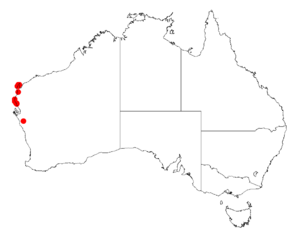Acacia ryaniana facts for kids
Quick facts for kids Acacia ryaniana |
|
|---|---|
| Conservation status | |
| Scientific classification | |
| Genus: |
Acacia
|
| Species: |
ryaniana
|
 |
|
| Occurrence data from AVH | |
Acacia ryaniana is a type of shrub that belongs to the Acacia plant family. It is a special plant because it is endemic, meaning it only grows naturally in a specific area along the west coast of Australia.
What it Looks Like
This shrub usually grows close to the ground, like a mat. It can be about 0.1 to 0.4 meters (0.3 to 1.3 feet) tall. Its branches are smooth and often have a white, powdery coating. It has sharp, spine-like parts called stipules, which are 2 to 6 millimeters long.
Like many Acacia plants, it doesn't have regular leaves. Instead, it has special flattened stems called phyllodes. These phyllodes are evergreen, meaning they stay green all year. They are shaped like an oval or a narrow ellipse, about 12 to 25 millimeters long and 7 to 15 millimeters wide. They are smooth and leathery, with one main vein and many tiny side veins.
Acacia ryaniana blooms from June to November. It produces bright yellow flowers. These flowers grow in round clusters, about 10 millimeters across. Each cluster can have 60 to 70 golden-colored flowers packed closely together.
After the flowers, light brown or yellow-brown seed pods grow. These pods are curved and bumpy over the seeds. They are smooth and can be up to 8 centimeters (3.1 inches) long. Inside, the seeds are arranged sideways or at an angle. The seeds are shiny, dark brown, and round or broadly oval, about 5 to 6 millimeters long. They often look lighter in the middle and have a small, narrow aril (a fleshy covering).
How it was Named
A botanist, who is a scientist who studies plants, named Bruce Maslin first officially described this plant in 1992. He wrote about it in a scientific journal called Nuytsia.
Later, in 2003, another botanist named Leslie Pedley reclassified it. This means he moved it to a different group of plants called Racosperma ryanianum. But then, in 2006, it was moved back to the Acacia group.
This shrub is part of a group of plants called the Acacia victoriae group. However, it stands out because it grows low to the ground and has curved seed pods.
Where it Grows
Acacia ryaniana is found naturally in the Mid West and Gascoyne regions of Western Australia. You can find it from the town of Northampton in the south up to Exmouth in the north.
It typically grows on sandy or clay soils, often over limestone, on coastal sand dunes. It is usually part of scrubland or heathland plant communities. You might often see it growing alongside a type of grass called spinifex.


